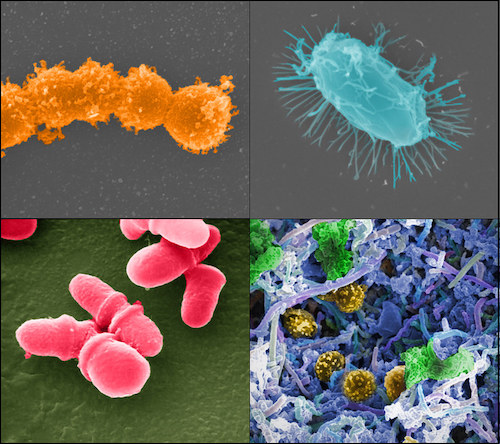Overuse of antibiotics might be making us more vulnerable to disease
Sunitha Chari, Biology and Life Sciences co-editor
Our gastro-intestinal tract is home to about 100 trillion (1014)) micro-organisms – bacteria, viruses and fungi – that together are called the gut microbiota. If that seems like a mind boggling number consider this: the human body comprises 10 times as many microbial cells as human cells. These microbes have established a symbiotic relationship with the human body over millions of years – our bodies provide them with nutrients and an environment to grow on, and they help defend us against invading pathogens and secrete various molecules to maintain our bodies’ health and homeostasis. New research is increasingly showing that this relationship is actually more important than we once thought, and that disruption of the microbiota can even lead to disease.
Remember the last time your stomach was upset and well-meaning friends and family told you to eat a bowl of yogurt? The reason yogurt helps you feel better is because it is a good source of Lactobacillus, a group of bacteria that reside in your intestinal tract. They are just one of the many types of friendly bacteria that call your gut home. The most abundant bacteria belong to the groups Bacteroidetes and Firmicutes while others belong to Proteobacteria, and Actinobacteria to name a few.
Some important functions of the gut microbiota include the synthesis of vitamin K, folate and vitamin B12; anti-inflammatory molecules like butyrate; and antimicrobial molecules that inhibit the growth of pathogenic bacteria. But perhaps one of the most important functions of the gut microbiota is in the development and maturation of our immune system.

Microbes associated with humans (Clockwise from top left): Streptococcus (Credit: Tom Schmidt); microbial biofilm of mixed species, from human body (Credit: A. Earl, Broad Institute/MIT); Bacillus (Credit: Tom Schmidt); Malassezia lopophilis (Credit: J.H. Carr, CDC). Credit for composite image: Jonathan Bailey, NHGRI. CC BY NC – National Institutes of Health Human Microbiome Project
The immune system functions by discriminating self from non-self. The nascent immune system scans the developing foetus and stores the information as a memory of “self”. This information is updated after birth when the immune system meets environmental bacteria, including the friendly gut microbiota. Since the immune system develops a tolerance to the microbes it encounters in early childhood, it is important for the baby to be exposed to the key members of the gut microbiota and the complete diversity of microorganisms that colonize the gut.
A healthy gut microbiota is also important for the proper functioning of the local immune system, known as the mucosal immune system because it is present in the mucous layer surrounding the intestines. The components of the mucosal immune system depend on cues from the friendly gut microbiota to maintain health and defend against invading pathogens.
Some of the factors that determine a healthy gut microbiota include the presence of all the important bacterial species, the full diversity of gut microorganisms, and the absence of pathogens. This is the balance that is necessary for maintaining health, also known as eubiosis. When this balance is upset, the condition known as dysbiosis manifests as disorders and diseases.
Since the discovery of penicillin by Alexander Fleming, antibiotics have played an important role in medicine. Antibiotics are effective against certain bacterial pathogens but ineffective against a host of other pathogens like viruses, fungi and parasites. Yet, antibiotics are often prescribed without the cause of the disease being diagnosed (proper diagnosis is called etiology). Antibiotics cannot distinguish between pathogens and the friendly gut bacteria, and the misuse of antibiotics is a major cause of dysbiosis. This is of greater concern when antibiotics are prescribed during pregnancy, childbirth, and during the first three years of a child’s life.
Analysis of amniotic fluid has shown that microbial colonization of the gut begins in utero. At childbirth, the infant obtains more micro-organisms from the mother – if it’s a vaginal delivery the baby obtains the microflora that colonize the mother’s vagina and if it’s a caesarean birth the baby obtains the bacteria that reside on the mother’s skin. After birth, the baby comes in contact with a diversity of microorganism from the breast milk, the mother’s skin and its environment.

Babies benefit more from mothers’ milk, which contains vital microbes that colonize babies’ guts, than from formula. Photo credit: Smmchapman CC BY SA 3.0
Certain types of bacteria colonize the gut of the infant during the first six months when the child’s food is mainly milk. Breast-fed infants are more resilient to antibiotic exposure than formula-fed babies because breast milk offers several protective factors. The gut microbiota of the mother is also present in her milk. When consumed, breast milk helps replenish the infant’s microbiota, and contains certain sugar molecules that are produced for the exclusive consumption of the infant’s microbiota. It also contains antibodies to the pathogens that the mother has already encountered and offers immunity to the infant against these invaders.
A child’s microbiota changes rapidly with the introduction of solid food at six months to one year of age and stabilizes to the composition of the adult microbiota at about 2.0–2.5 years. This time in the child’s life is crucial for building and maintaining the proper and full complement of gut microbiota.

Photo credit: Vera Kratochvil CC0, via PublicDomainPictures
Dr. Anita Korzyrskyj, an epidemiologist at the University of Alberta, studies the prevalence, distribution and possible links between antibiotics and diseases like obesity, allergies and atopy. Her work shows that antibiotic intrapartum prophylaxis predisposes children to obesity by changing their metabolism, and also to asthma and allergies because of disturbances to the immune system. Some of the common reasons for administering antibiotics during childbirth are Group B Streptococcus infection, pre-labour rupture of membranes and a caesarean birth.
Korzyrskyj’s research shows that while it is possible to shift the balance of gut microbiota back to eubiosis after short-term antibiotic exposure, the overall change in microbiota composition and its effect on health depends on the degree of exposure. Taking antibiotics frequently can alter the gut microbiota permanently and, it seems, may cause disease. Although no definitive causal link exists between antibiotic use, gut microbiota composition, and disease, evidence of a connection that requires careful investigation is growing.
While it is possible to offset some effects of antibiotics with diet and lifestyle, a better solution might lie in a more judicious approach to antibiotic use than the one practised currently. This involves the co-operation of both patients and healthcare practitioners. So, the next time you visit the doctor ask her what the etiology of the disease is and why you or your child is being prescribed antibiotics.
~30~
Banner image photo credit: Makelessnoise CC BY 2.0




